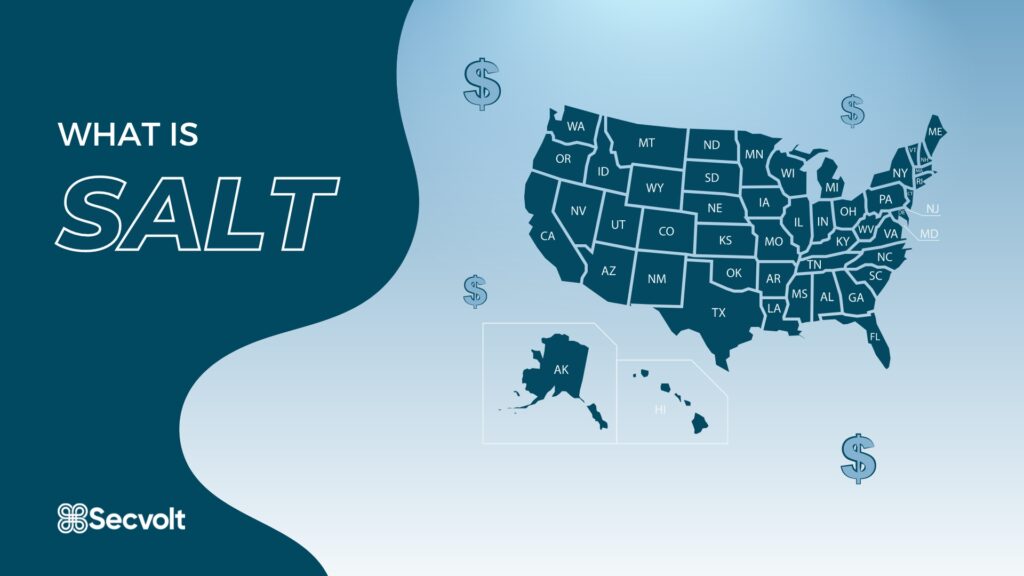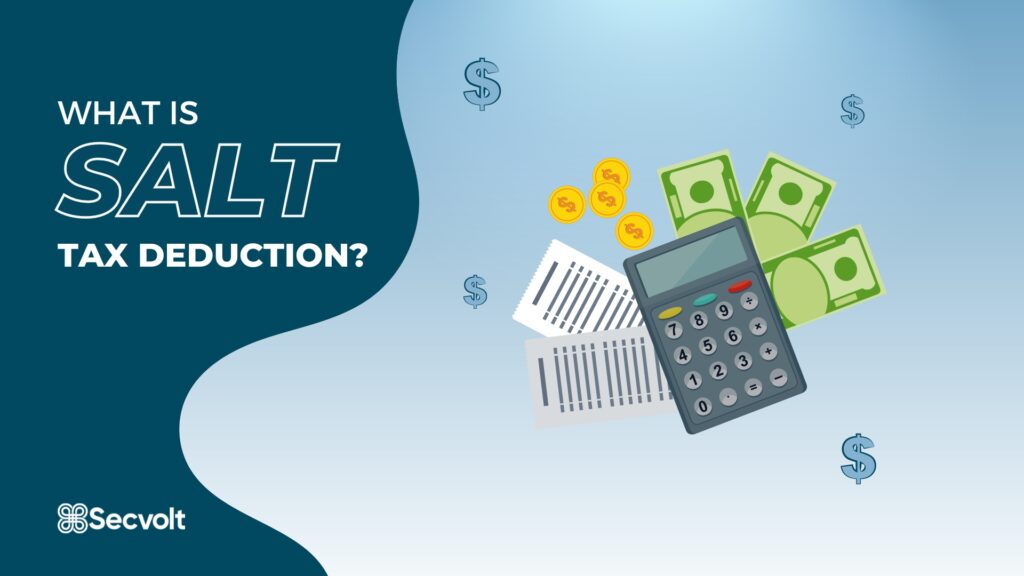
How To Reduce Excess SALT Deductions?
Are you tired of seeing excessive salt deductions on your paychecks? Do you find yourself continuously battling to make ends meet as a result of excessive tax withholdings? If so, you are not alone. It may be irritating and upsetting to be in this scenario, which many individuals find themselves in.
But don’t worry – there are steps you can take to reduce excess salt deductions and keep more of your hard-earned money in your pocket. In this blog post, we’ll go over some simple strategies you can use to lower your salt deductions and increase your take-home pay. If the phrase ‘deduction’ caught your eyes and ‘SALT’ is confusing you, let’s start with the basics then.

What is SALT?
State and local tax (SALT) is a type of tax that is levied by state and local governments on individuals and businesses within their jurisdiction.SALT can appear in a variety of ways, such as income tax, sales tax, property tax and other taxes.
SALT contributes significantly to the funding of state and local government services and initiatives, including infrastructure, public safety, and education. The amount of SALT that a person or organization must pay can vary greatly based on the country or region in which they reside or conduct business, as well as the types of taxes that are levied.
That’s the easiest way to define SALT. Now, let’s come to the second phrase- Deduction and how these two words are connected.

What is SALT Tax Deduction?
SALT deduction is a tax deduction that allows individuals and businesses to claim a deduction for certain state and local taxes on their federal income tax return. The SALT deductions can be a valuable tax benefit, but they are subject to a decided cap which is discussed in the next section.The SALT deduction is claimed on a taxpayer’s federal income tax return and can reduce the amount of federal income tax that they owe.
The SALT deduction was an unlimited deduction prior to the Tax Cuts and Jobs Act of 2017, which allowed taxpayers to deduct all of their state and local taxes from their federal income taxes. The Tax Cuts and Jobs Act, however, put a $10,000 annual ceiling on the SALT deduction, restricting how much may be claimed by individuals. This cap covers all state and local taxes, including income tax, property tax, and sales tax, that a taxpayer is responsible for paying.
The SALT deduction can be a valuable tax benefit for individuals who pay significant amounts of state and local taxes. However, the cap on the SALT deduction may limit the benefit of this deduction for some taxpayers. So, if you wonder whether there is a way to eliminate the SALT cap, check the next segment.

What is the SALT Cap Workaround?
The SALT cap workaround refers to strategies that individuals and businesses may use to reduce or eliminate the impact of the state and local tax (SALT) deduction cap. The SALT deduction cap is a limit on the amount of SALT that taxpayers can claim as a deduction on their federal income tax return. The SALT cap is currently set at $10,000 per year ($5,000 if you are married and file a separate return).
Some taxpayers may try to use a SALT cap workaround to claim a larger SALT deduction on their federal income tax return. There are several potential strategies that may be used as part of a SALT cap workaround, including:
- Prepayment of SALT: Some taxpayers may try to prepay their SALT in the year before the cap goes into effect in order to claim the deduction on their federal income tax return.
- Charitable contributions in place of SALT: Some taxpayers may attempt to make charitable contributions to organizations that are eligible to receive tax-deductible gifts in lieu of paying SALT. They might be able to use this to replace the SALT deduction with a charity deduction on their federal income tax return.
- Use of a trust or other entity: Some taxpayers may try to use a trust or other entity to pay their SALT on their behalf. This may allow them to claim the SALT deduction without being subject to the cap.
It’s important to note that the Internal Revenue Service (IRS) has taken steps to prevent taxpayers from using these and other strategies to evade the SALT cap. Moreover, you need to understand the rules for claiming the SALT deduction. This brings us to our next section wherein you can learn about how much you can deduct for SALT.

How Much Can I Deduct for State and Local Taxes?
The amount of state and local taxes (SALT) that you can deduct on your federal income tax return is generally limited to $10,000 per year ($5,000 if you are married and file a separate return). This limit applies to the total amount of SALT that you pay, including income tax, property tax, and sales tax.
To claim the SALT deduction, you must itemize your deductions rather than claiming the standard deduction on your federal income tax return. To itemize your deductions, you must complete Schedule A (Form 1040), Itemized Deductions, and include your state and local tax payments on this form. The SALT deduction is then calculated by subtracting the amount of the deduction from your taxable income.
It’s important to note that the SALT deduction is just one of several deductions that you may be able to claim if you itemize your deductions. Other deductions that you can claim on Schedule A include charitable contributions, mortgage interest, and medical expenses, among others. You should consider all of the deductions that you may be eligible to claim when determining whether it is more beneficial to itemize your deductions or claim the standard deduction.
If you need some ideas about what to read next, here they are:
- Using Alternative Investments To Minimize Risks & Maximize Returns
- Recession Or The Next Great Depression? How To Survive And Thrive Afterward
- Winter Begins With Everything Steamy In The Crypto World

What State and Local Taxes Can Be Deducted?
State and local taxes (SALT) may be deducted from federal income taxes in the following cases:
- Income tax: State and local income taxes paid on paychecks, salaries, and other forms of income may be deductible.
- Property tax: Property taxes paid by the state and local governments on real estate and personal property may be deductible.
- Sales tax: State and local sales taxes paid on the purchase of goods and services may be deductible.
- Other types of SALT: Other types of state and local taxes, such as excise taxes, use taxes, and other taxes, may also be deductible.
After reading all this, you must be wondering if there is a way to reduce the amount of SALT tax. There are some ways given in the following segment that can save you from paying pocket cutting Tax amounts.

How to Pay Less SALT Tax?
There are several strategies that individuals and businesses may use to pay less state and local tax (SALT):
- Take advantage of tax credits and deductions: Many states and localities offer tax credits and deductions that can help reduce the amount of SALT that you owe. For example, you may be able to claim a credit for making energy-efficient home improvements or for making charitable contributions.
- Plan your income and deductions carefully: Properly planning your income and deductions can help you minimize your SALT liability. For example, you may be able to reduce your SALT by timing the receipt of income or by maximizing deductions such as charitable contributions or business expenses.
- Choose your place of residence or business carefully: The amount of SALT that you owe can vary significantly depending on the state and locality in which you live or operate your business. Choosing a jurisdiction with lower SALT rates can help reduce your tax burden.
- Consider using a tax-advantaged retirement account: Contributions to certain types of tax-advantaged retirement accounts, such as a 401(k), Roth IRA or an IRA, may be deductible for SALT purposes. This can help reduce your SALT liability.
- Work with a tax professional: A tax professional can help you identify tax-saving opportunities and develop a plan to minimize your SALT liability.
It’s important to note that the specific strategies that are available to you will depend on your individual circumstances and the tax laws and regulations that apply in your jurisdiction. Many people wonder whether the SALT deductions will be removed or not. If you want to find out too, the next segment has your answer.

Will SALT Deductions Be Removed?
It is not currently known whether the state and local tax (SALT) deductions will be removed in the future. The SALT deductions are a tax attribute that allows taxpayers to deduct various state and local taxes from their federal income tax returns, including income tax, property tax, and sales tax.
The SALT deductions have been a part of the federal tax code for many years, but they have been the subject of significant debate and controversy in recent years. The Tax Cuts and Jobs Act of 2017 placed a cap on the SALT deductions, limiting the amount that taxpayers can claim to $10,000 per year ($5,000 if you are married and file a separate return). This cap has been the subject of legal challenges and has been a controversial issue for some taxpayers and lawmakers.
It is possible that the SALT deductions could be modified or eliminated in the future as part of tax reform or other changes to the federal tax code. However, any such changes would be subject to the legislative process. It is not possible to predict with certainty what changes, if any, may be made to the SALT deductions in the future.
For high net worth individuals (HNIs), it may be particularly important to manage their SALT deductions in order to minimize their tax liability. HNIs may be able to use some of the strategies mentioned above, such as taking advantage of tax credits and deductions or carefully planning their income and deductions, to reduce their excess SALT deductions. HNIs may also want to consider working with a tax professional to develop a customized strategy to minimize their SALT liability.
Conclusion
Excess SALT deductions can increase your tax liability and may be subject to additional taxes or penalties. By using the strategies discussed in this blog, you can reduce your excess SALT deductions and minimize your tax liability. It’s important to carefully consider different options to ensure that you are taking advantage of all available tax-saving opportunities.
For more insights on similar topics, visit www.secvolt.com.
Secvolt is a quant hedge fund that safeguards your investments and provides better results than its peers. It generated a YTD of 262.10% in 2022 when the market was struggling to generate bare minimum profits.





